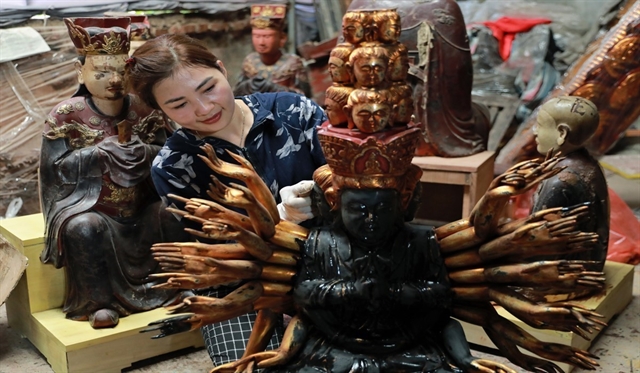 Society
Society

 |
| A Sơn Đồng craft village's artisan completes her product. — Photos courtesy of the Hà Nội Department of Agriculture and Environment |
HÀ NỘI — Hà Nội is steadily realising its long-term vision to preserve and promote the values of more than 1,350 craft villages across the capital.
At present, among over 1,350 craft and semi-craft villages, the city has 337 officially recognised traditional craft villages.
These communities not only provide employment for hundreds of thousands of rural workers but also serve as living spaces preserving the cultural essence of Thăng Long.
However, many of them still face challenges such as small-scale production, limited product value, environmental pollution, and inadequate infrastructure.
To address these issues, in January 2025, the Hà Nội People’s Committee approved the comprehensive plan under Decision No. 282/QD-UBND.
The plan identifies 11 key groups of solutions, focusing on improving planning, infrastructure investment, application of science and technology, human resource training, digital transformation, trade promotion, and international cooperation.
Notably, Hà Nội will implement special mechanisms under the amended 2024 Capital Law, providing preferential policies on credit, taxation, and production support for craft villages.
The implementation of the “Comprehensive Plan for Craft Village Development for the 2025-30 period, with a vision to 2050” marks a strategic step toward turning Hà Nội’s craft villages into symbols of green economy, cultural tourism and creative craftsmanship both regionally and globally.
Nguyễn Đình Hoa, Deputy Director of the city’s Department of Agriculture and Environment, said the plan is not only an economic development programme but also a cultural preservation strategy.
“Hà Nội enjoys a major advantage as the revised Capital Law allows the city to develop specific policies to comprehensively promote craft villages - preserving traditions while adapting to the green economy and clean production trends,” Hoa said.
The plan outlines eight priority tasks to ensure feasibility and synchronisation: conserving traditional villages at risk of decline; developing craft villages in connection with tourism and the green economy; improving infrastructure; addressing environmental issues; applying new technologies; advancing OCOP (One Commune - One Product) initiatives; training high-quality human resources; and promoting product branding.
Accordingly, Hà Nội will develop comprehensive policies to support rural industries, organise the 2025 Hà Nội Craft Village Product Contest, and host the International Craft Village Conservation and Development Festival.
 |
| Ceramics production in Bát Tràng ancient village. |
The city has also proposed that the World Crafts Council (WCC) recognise Chuyên Mỹ (mother-of-pearl inlay) and Sơn Đồng (wood carving and sculpture) villages as members of the World Network of Creative Craft Cities - further enhancing Hà Nội’s position on the global handicraft map.
At the same time, ten new titles of “Craft Villages, Traditional Crafts, and Traditional Craft Villages” will be awarded in 2025, honouring and encouraging communities to continue innovating while preserving their heritage.
According to the Rural Development Division of the city’s Department of Agriculture and Environment, among the city’s 1,350 craft villages, over 300 specialise in handicrafts, including ceramics, woodwork, lacquerware, bamboo and rattan weaving, and mother-of-pearl inlay.
The United States remains the largest export market, accounting for about 35 per cent of Hà Nội’s annual export turnover, followed by Japan, the European Union, Australia, and the Republic of Korea.
Many Hà Nội craft brands - such as Bát Tràng ceramics, Chuyên Mỹ inlay, and Phú Vinh bamboo and rattan - have successfully established their reputations in high-demand international markets.
Hà Thị Vinh, Chairwoman of the Hà Nội Handicraft and Craft Village Association, the city’s craft village development plan was introduced “at the right time,” creating great opportunities for artisans and businesses.
“Hà Nội’s craft village products hold enormous potential for growth, especially as cultural industries are emerging as a key driver of the economy,” Vinh said.
Boosting experiential tourism
Beyond export goals, Hà Nội is now pursuing a model that combines craft village preservation with experiential tourism.
Visitors to the capital can join craft tours - from pottery making in Bát Tràng and wood carving in Sơn Đồng to silk weaving in Vạn Phúc.
Under the city’s plan, by 2030, Hà Nội will establish 10 official craft village tours, turning these local communities into attractive cultural destinations within Việt Nam’s tourism landscape.
One of the key highlights of the 2024 Capital Law is Clause 8, Article 21, which allows for the creation of “Trade and Cultural Development Zones” within craft villages and rural residential areas.
This provides an important legal framework for developing integrated models of preservation and growth, advancing both cultural industries and sustainable tourism.
 |
| Nguyễn Đình Hoa, Deputy Director of the city's Department of Agriculture and Environment, delivers a keynote address at the workshop “Solutions for Implementing the Comprehensive Plan for Craft Village Development in Hà Nội for the 2025–30 Period, with a Vision to 2050.” |
Phạm Huy Khôi, Chairman of the Bát Tràng Commune People’s Committee, said: “We are implementing the Bát Tràng Eco-Museum Project - a public-private partnership model designed to preserve the traditional pottery craft while promoting the cultural and ecological values of this ancient village.”
Bát Tràng currently welcomes about 200,000 visitors annually, 20 per cent of whom are international tourists.
Once completed, the Bát Tràng Eco-Museum and Trade-Cultural Development Complex is expected to attract up to one million visitors per year, significantly contributing to the development of Hà Nội’s cultural industries.
Under the plan, by 2030, Hà Nội aims to restore and preserve at least five endangered traditional crafts and villages; recognise 25 new craft villages; develop three craft villages associated with tourism; ensure that all craft villages meet environmental standards; and achieve efficient operations in 80 per cent of them.
The average annual production value growth is projected to reach 10 per cent.
By 2050, Hà Nội envisions a network of green, clean, and modern craft villages - where handmade products are not merely commodities but also cultural ambassadors of Việt Nam, meeting international standards and enjoying brand protection abroad.
The city aspires to become a leading center for handicraft exchange, exhibitions, and innovation in the Asia-Pacific region.
Hà Nội’s comprehensive craft village development plan is not just a roadmap for reviving traditional crafts but a strategic vision for sustainable growth-where culture, technology, and creativity converge.
From the skilled hands of artisans in Bát Tràng, Sơn Đồng and Phú Vinh, Vietnamese craft products are being revitalised with new energy, carrying the unique soul of the millennia-old capital to the world. — VNS
* The article was produced in collaboration with the Hà Nội Department of Agriculture and Environment.




